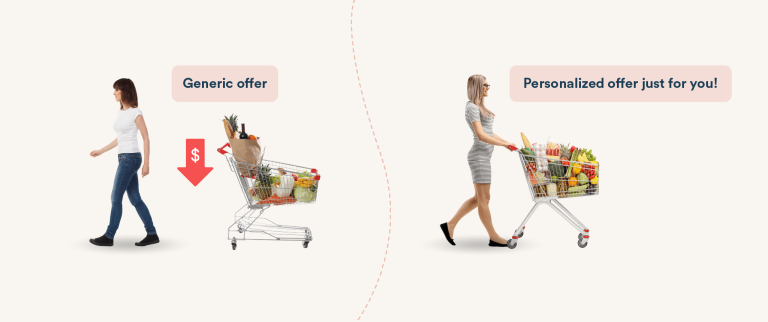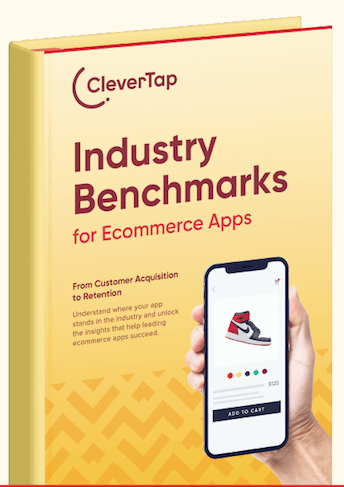Learn how you can Unlock Limitless Customer Lifetime Value with CleverTap’s All-in-One Customer Engagement Platform.

Apologies in advance to ecommerce marketers out there, but we have a discouraging statistic to report.
Did you know that the average cart abandonment rate is just over 70%?*
Yikes.
Of course, even if this number were cut in half, cart abandonment would still be a massive headache for your and your ecommerce business, because it translates to sales and revenue that were lost.
However, there has emerged a powerful strategy to address this issue. Can you guess what it is? Personalization! By tailoring the shopping experience to each individual customer, you can minimize cart abandonment rates and improve overall conversion rates.
In this blog post, we explore the role of personalization in reducing cart abandonment rates and we’ll provide actionable tips to implement effective personalization strategies.
Before diving into the role of personalization, it’s important to understand the reasons behind cart abandonment. Common factors include unexpected costs, complicated checkout processes, lack of trust, and distractions. By identifying these pain points, you can target personalized solutions to address them effectively.
One way to personalize the shopping experience is by providing relevant product recommendations based on the customer’s in-ap behavior and purchase history. By leveraging data analytics and machine learning algorithms, you can present personalized suggestions that align with the customer’s actions and increase the likelihood of completing the purchase.
2. Remind Customers of Their Abandoned Cart
Sending personalized cart abandonment emails or push notifications can be highly effective in re-engaging customers, reminding them about their pending purchases. Include dynamic content in these messages, such as images and descriptions of the abandoned products, and offer incentives such as discounts or free shipping to entice customers to return and complete their purchase.
3. Simplify the Checkout Process
Complex and lengthy checkout processes can frustrate customers and lead to cart abandonment. Personalization can help simplify this process by pre-filling customer information, such as shipping addresses or payment details, based on previous orders or saved profiles. By streamlining the checkout process, you can make it quicker and more convenient for customers to complete their purchases.
4. Use Real-Time Social Proof
Incorporating real-time social proof, such as customer reviews or testimonials, can instill trust and confidence in potential buyers. Personalize these social proof elements by showing reviews from customers with similar preferences or demographics. This personalized validation can alleviate concerns and increase the likelihood of customers following through with their purchases.
5. Provide Live Chat Support
Offering personalized live chat support during the checkout process can be invaluable in reducing cart abandonment. Customers may have specific questions or concerns that, if addressed in real time, can alleviate doubts and increase their confidence in making a purchase. Train customer support representatives to provide personalized assistance and resolve issues promptly.
6. Implement Exit Intent Pop-ups
Exit intent pop-ups are triggered when a user is about to leave the website without completing the purchase. Personalize these pop-ups by offering targeted discounts, personalized recommendations, or limited-time offers to incentivize customers to reconsider their decision and complete the transaction. These personalized incentives can be powerful motivators to reduce cart abandonment rates.
7. Leverage Behavioral Triggers
Identify specific user behaviors or actions that indicate potential cart abandonment and trigger personalized interventions. For example, if a customer spends a significant amount of time on a product page without adding it to the cart, you can send targeted messages or offers to address any concerns or provide additional information that might encourage the purchase. And, using behavioral analytics can also improve the user experience.
8. Optimize the Mobile Experience
A survey conducted by Newstore in 2022 found that 31% of consumers prefer to do their shopping in-app to in-store shopping. And a whopping 60% of consumers prefer mobile shopping apps over mobile sites because of better user experience, while 88% of consumers have at least one shopping app on their phone.*
Due to the increasing popularity of mobile devices for online shopping, it’s crucial to optimize the mobile experience to reduce cart abandonment. Ensure that your website or app is mobile-friendly, with responsive design, easy navigation, and simplified checkout processes. Personalize the mobile experience by tailoring the interface and content to fit smaller screens and mobile user behaviors.
9. Analyze and Iterate
To maximize the effectiveness of personalization strategies in reducing cart abandonment rates, it’s crucial to continuously analyze data and iterate on your personalization efforts. Monitor key metrics such as cart abandonment rate, conversion rate, and customer feedback to gauge the impact of your personalized strategies. Use A/B testing to experiment with different personalization tactics and identify what resonates best with your target audience.
Yes, cart abandonment will likely always be a challenge for ecommerce businesses. But, if you can provide a more personalized experience and personalized recommendations, you can effectively combat it.
By tailoring the shopping experience to individual customers, you can address pain points, build trust, and increase the likelihood of completing a purchase. From personalized product recommendations to simplified checkout processes, personalization plays a vital role in reducing cart abandonment rates.
But wait, there’s more….
Reducing cart abandonment is just one part of a comprehensive approach that combines personalization with other techniques to improve conversions. By combining personalized strategies with trust-building elements, transparent pricing, clear shipping information, and excellent customer support, you can create a compelling shopping experience that minimizes cart abandonment and maximizes conversions.
Implementing effective personalization strategies may require the use of a customer engagement platform like CleverTap. CleverTap’s advanced features and capabilities empower your business to leverage data-driven personalization techniques, automate personalized messaging, and deliver a tailored experience to each customer, ultimately reducing cart abandonment rates and driving higher conversion rates.
Start harnessing the power of personalization to combat cart abandonment and transform your ecommerce business into a conversion powerhouse.
To see how your ecommerce app compares to the rest of your industry, download our latest benchmark report.

Industry Benchmarks for Ecommerce Apps